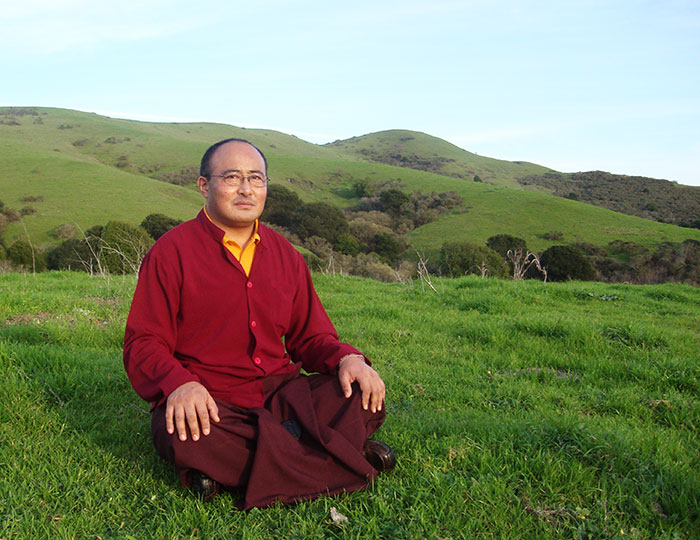
The 11th Incarnation of Pema Lingpa, Lhalung Sungtruel Rinpoche – the founder of Pema Lingpa Foundation
Last year, the Ministry of Home and Cultural Affairs has issued an executive order to celebrate contributions of a native Buddhist scholar Pema Lingpa. This came after almost 500 years since his passing away.
Pema Lingpa (1450-1521) is considered one of the greatest five masters of treasure teachings, referred to as ‘Five Kings of the Treasure-Finders’ in Nyingma tradition of Tibetan Buddhism. The history of Pema Lingpa starts with his first meeting with Guru Rinpoche towards the end of eight century, when Buddha Dharma was gaining a stronghold in Tibetan empire under leadership of King Thrisong Duetsen.
The king invited Guru Rinpoche to help him establish Buddhism. During the time, one of the king’s daughters, Pemasel, died unexpectedly on her eighth birthday. Upon noticing the king’s great sorrow over the death of his only daughter, Guru Rinpoche drew princess Pemasel’s consciousness back into her body. When she regained awareness, Guru Rinpoche transmitted his secret teachings and prophesied her to reveal the teachings in her future life. She was told that she would be reborn as one of the greatest terton by the name Pema Lingpa.
Accordingly, in 1450, Pema Lingpa was born in Threl Baridrang of Tang valley in Bumthang. At a very young age, he was sent to live with his grandfather Yonten Jangchub, a blacksmith. At the age of nine, young Pema Lingpa began to apprentice as a blacksmith. As he grew up, he crafted many works such as making millstones, iron-pan, chainmail, swords and ceremonial knives, which can be still found around Bhutan. Despite his early inclinations toward Buddhism, he spent much of his young adulthood working as a blacksmith.
However, at the age of twenty-seven, he experienced a prophetic dream and later revealed many treasures teachings. He gave his first teachings at Dunkhabi in Bumthang. All his profound teachings were compiled in twenty-one volumes of Peling Choekhor Chuksum. These texts contain empowerment and practice manuals associated with the three most important cycles of teachings and practices: the cycle of Guru, the cycle of the deity of compassion, and the cycle on Great Perfection – Dzogchen. His teachings were highly regarded by numerous socio-political champions in the region including Zhabdrung Ngawang Namgyel, who had high regards for the first Gangteng Trulku. The veneration of Peling treasures by 5th Dalai Lama is also revealed in murals of Lhasa’s secret Lukhang temple.
Pema Lingpa’s lineage is passed down through three primary lines of incarnations, one direct line of his own reincarnations (Peling Sungtruel), and two stemming from his son and grandson: Peling Thukse, and Peling Gyalse, popularly known as the Gangteng Trulku. Currently, the Peling tradition in Bhutan is seen everywhere from Paro to Trashigang, and from Zhemgang to Trashiyangtse. The teachings of Pema Lingpa are practised in all those places through means of tshechus, lochoe, retreats and other forms. The main seats of Peling lineage at Gangteng, Tamshing and Drametse currently provide all kinds of amenities for any individual wishing to pursue scholarly education in Peling tradition.
The Royal Family of Bhutan comes from the lineage of Pema Lingpa, descending from the union of the great house of Dungkhar Choeje, Tamzhing Choeje and Chumey Zhelngo. His significance to Bhutanese society can be summarised in words of Gangteng Trulku Rinpoche:
“Pema Lingpa is the quintessential Bhutanese master. He is the only one who embodies the country of Bhutan so totally. He was completely homegrown. His lineage, his family, his ethnicity were all completely Bhutanese. The treasures he discovered were here in Bhutan, where he encountered Padmasambhava and Yeshe Tsogyal face to face. He did all his study and practice here in Bhutan. And all his work for the benefit of beings happened here in Bhutan. So, he is really the epitome of Bhutan, a great role model of a Bhutanese person whose activities took place within these borders.”
Contributed by
Karma
Chairman of Pema Lingpa Foundation
karmajurmey@gmail.com

